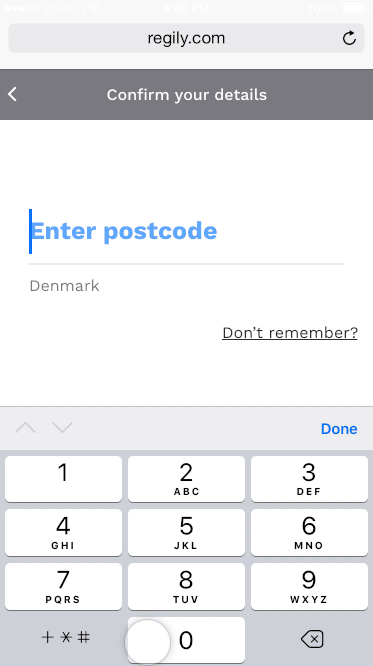One of the teams at Regily many of you are familiar with Partner Success - it consists of four passionate souls eager to see our partners succeed. We love to see you grow, both in terms of conversion rate, user base, and as a brand. Partner Success helps you integrate and optimize your flow, and we are more than happy to assist you with any questions you might have.
Localization
We are always looking for ways to create localized flows that give better conversion and great user experience in any market. That’s why we spend a lot of time trying out new suppliers and find the best data sources to meet the end user’s expectations wherever they are located. Below are a few examples of localization features for some of the markets our partners have recently entered.
Danish address lookups 🇩🇰
Denmark has a bit of an unusual house number structure, where a lot of information such as apartment number and the floor is connected to the number itself. After testing several sources, we have found a supplier that gives extremely accurate address lookups. End-users only have to type their house number and they will get a drop-down list of all addresses connected to that number. This leaves zero room for human mistakes, is a pleasant experience for the user, and makes sure you get the full address according to Danish standards in the callback data.
Support for non-Latin alphabets ⌨️
You cannot get a 100% localized sign-up flow without support for the local language. We have partners recently expanding to Russia - hence we have added support for input and output in the Cyrillic alphabet. We already have support for Japanese and Chinese, among other non-Latin alphabets.
Every time we prepare for a new market, we do extensive research and tests to find the very best data sources that give the most accurate results and better conversion. Here are some examples of localized tweaks we already have in place:
One-line address input for India 🇮🇳
India doesn’t have a very good postal code structure so we needed to find other ways to look up addresses. Our tests found that a supplier that gives address suggestions meanwhile the user types converts best in India, so that is the solution we use in our India flow.
Address look-ups Japan 🇯🇵
Japan, on the other hand, have a very well used postal code structure. When an end-user types their postal code, we do a specialized lookup that returns the prefecture (Japanese local entity) and city. The user then only has to type their house number to complete their address.
India now among top 10 markets 🔥
People from all over the world enjoy seamless sign-ups with our framework and in the last few weeks, many of our partners have had their eyes on India. It didn’t take long before India accompanied countries such as Canada, the US, Germany, the UK, and Sweden as one of our 10 biggest markets. More and more sign-ups from India means more and more behavioral data that will give us exciting insights into Indian users’ habits and expectations when signing up online.
Overview screen experimentation
One of our current ongoing experiments is to find ways to decrease drop-offs in the very first step of the flow, the overview screen. This is by far where most drop-offs happen for every partner within all industries.
We are testing various variants of how we visualize how far the user has come in the flow. We know from the previous testing that showing progress on every single step does not increase conversion, you can imagine yourself - seeing “you’re on step 3/15!” does not make you very excited to finish the sign-up. The purpose of showing a user how far in the process they are is to positively encourage them to finish the registration.
Progress should only be shown at strategic places that we see increase conversion, and dynamically adapt to the length of a flow - a longer flow will show progress less often than a shorter one.
Apart from experimenting with where and how often we show the progress, we are also being creative with how we show it. This can be done in many more different ways than the traditional “you are at step X out of X” - with a cool chart, in percentages, with fun animations or quirky copy to mention a few. With machine learning, the system continuously teaches itself what gives best results.
We are currently testing this on a few selected partners on mobile, and as soon as we have finished testing the best solution will be rolled out for everyone.
Hope you enjoyed the read, feel free to reach out if you have any questions, feedback or input - we're always happy to help!